Ferrari 812 Superfast 2017
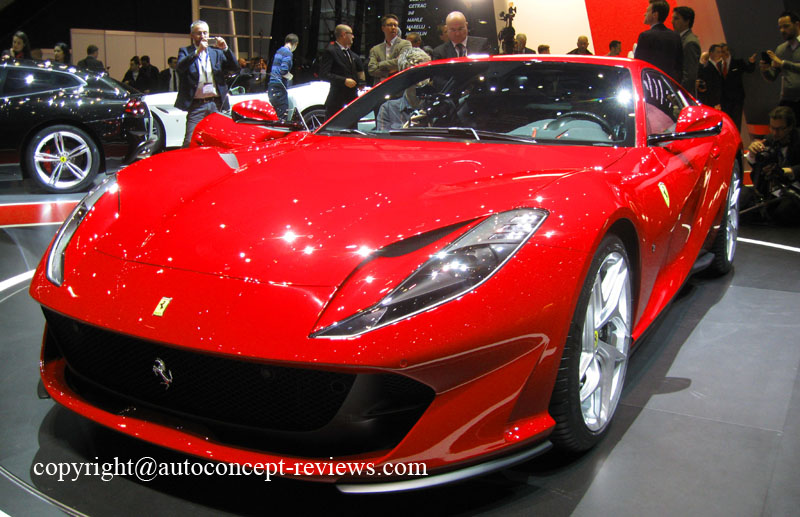
The first and most difficult challenge Ferrari always faces when it decides to develop a new model is to push the boundaries of its own achievements yet again. This challenge is made all the tougher when the task at hand involves designing a new 12-cylinder engine, the power unit that hailed the start of the glorious Prancing Horse story 70 years ago in 1947.
The obsessive pursuit of the most seamless melding possible of state-of-the-art running gear with a harmonious yet edgy design from the ever-inventive Ferrari Styling Centre, has produced a near-perfect aerodynamic package.
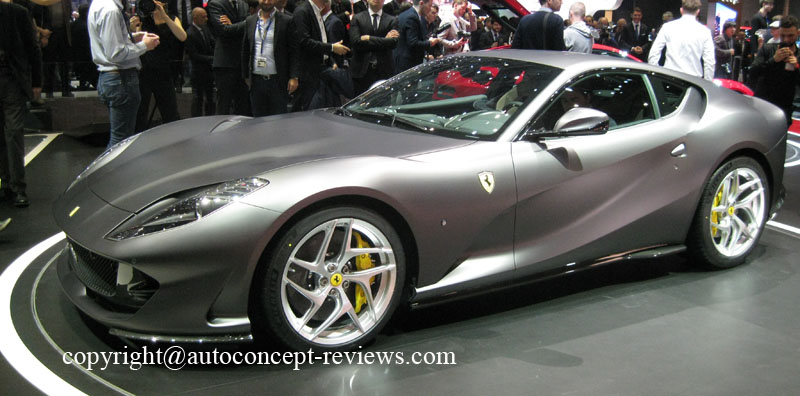
The 812 Superfast’s exceptionally futuristic, finely-honed lines also, however, clothe Prancing Horse power at its rawest, as an entirely new 12-cylinder engine of unprecedented efficiency and might was designed for the car.
That engine’s output has been boosted by 60 cv compared to the Ferrari F12 berlinetta, so that it unleashes a massive 800 CV, making the 812 Superfast the most powerful and fastest road-going Ferrari ever built (with the exception, of course, of the mid-rear-engined, special limited-series 12-cylinders). The 812 Superfast thus ushers in a new era in Ferrari 12-cylinder history, in doing so, building on the invaluable legacies of the F12berlinetta and F12 tdf.
To make full use of that huge power and to guarantee perfect weight distribution, the car exploits a highly evolved transaxle architecture that couples a front-mounted engine with a rear-mounted transmission.
The 812 Superfast is equipped with leading-edge vehicle dynamics control systems and components. It is striking for both its highly innovative design and aero package, as well as its unparalleled handling. It is also the first Ferrari to sport EPS (Electric Power Steering).
Simply put, the 812 Superfast is the new benchmark for mid-front-engined sports cars. And at its heart is the new 12-cylinder which has forged its character.
Engine and transmission
The challenge Ferrari tackled with the 812 Superfast was to design the most powerful road-going engine in the marque’s history (800 cv, 123 cv/l) whilst contemporaneously cutting fuel consumption and emissions, and, naturally, retaining the inimitable Ferrari 12-cylinder soundtrack.
At the development stage, the engineers set themselves the goal of exceeding the specific power output of the F12berlinetta’s V12 which itself delivered class-topping performance. To do so, they decided to focus their efforts principally on optimising the intake system and combustion efficiency to fully exploit the increase in the engine’s displacement from 6.2 to 6.5 litres. These aspects increased the maximum amount of air that could be drawn into the engine (and thus its power output) thereby boosting its efficiency.
The development process resulted in a maximum power output of 800 cv at 8,500 rpm, a new benchmark for the Ferrari range, in addition to a specific power output of 123 cv/l, a completely unprecedented figure for an engine front-mounted in a production car.
The torque curve illustrates this impressive improvement on the F12berlinetta in terms of acceleration and instantaneous power, particularly at high revs.
These performance levels were achieved in part by optimising the engine design and in part by introducing innovations, such as the use of a 350 bar direct injection system for the very first time on a spark-ignition engine, and the control system for the variable geometry inlet tracts, developed on naturally-aspirated F1 engines, which is a further evolution on its application on the special limited-series F12tdf.
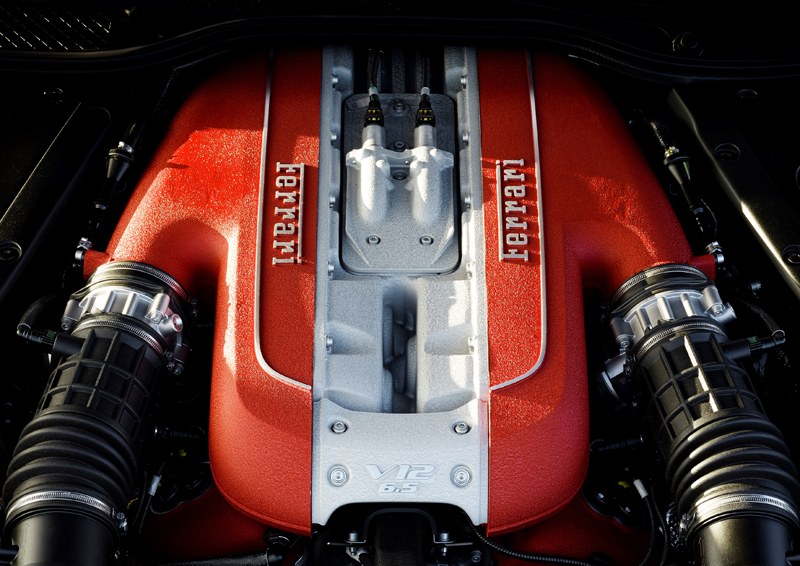
These systems allow the increase in displacement from 6.2 to 6.5 litres to be exploited to maximise power output whilst retaining excellent pick-up even at low revs.
The high pressure injection system also improves nebulisation of the injected fuel thus dramatically reducing the the amount of particulates emitted when the catalytic converter is warming up, ensuring the engine complies with all emissions regulations.
The engine’s maximum power-to-fuel consumption ratio has also been improved, attesting to the engine’s exceptional efficiency in urban driving contexts. This was achieved in part as a result of Stop&Start On the Move strategies which cut and restart the engine while the car is moving.
The result of all these developments is a boost in maximum power output to 800 cv at 8,500 rpm (an impressive 60 cv more than the F12berlinetta) and maximum torque of 718 Nm @ 7,000 rpm - a completely unprecedented achievement for a naturally-aspirated Ferrari production engine.
A significant 80% of maximum torque is available at just 3,500 rpm, improving both flexibility and pick-up at lower revs. The shape of the power curve, which rises constantly all the way to the maximum revs of 8,500 rpm, and the rapidity with which engine speed increases, thanks to low inertia, give occupants the feeling of boundless power and acceleration. The latter sensation comes courtesy of the overall increase in maximum power output and the optimisation of the afore-mentioned power curve between 6,500 and 8,900 rpm, which maximises the average horse power exploitable for press-on track driving when engine revs are kept consistently high.
The new 812 Superfast is fitted with Ferrari’s F1 dual-clutch transmission which has been further evolved to meet the car’s track driving performance targets and cope with the boost in maximum revs to 8,900 rpm. The gear ratios on all of the gears have been shortened by an average of 6% to exploit the extra performance and higher revs to the fullest as well as to improve the car’s acceleration without compromising pick-up in higher gears
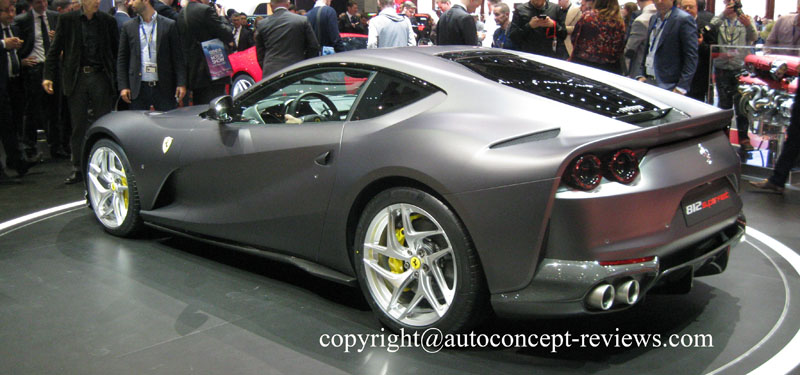
Vehicle Dynamics
The 812 Superfast is the first Ferrari to introduce Electric Power Steering (EPS) which, in line with Ferrari tradition, is used to fully exploit the potential of the car in terms of performance by integrating it with all of the electronic vehicle dynamics controls.
The car also sees the introduction of the Virtual Short Wheelbase 2.0 system (PCV) which, starting from the experience gained with the F12tdf, combines electric front-wheel steering assistance with the mechanical concept built around tyre dimensions and the rear-wheel steering. All integrated with the vehicle dynamics control systems based on Version 5.0 of the SSC, with the aim of improving the agility and response time to steering wheel inputs of the 812 Superfast.
The integration of the EPS enabled Ferrari’s engineers to introduce functionalities to support the driver's performance experience by means of the primary interface with the road: the steering wheel.
Ferrari Peak Performance (FPP): when cornering, the steering wheel torque will provide the driver with an indication that the car is getting closer to its limit of grip, helping the control of that dynamic state.
Ferrari Power Oversteer (FPO): in case of oversteer, most frequently induced while powering out of corners, the steering wheel torque will give the driver feedback to give steering wheel inputs that are coherent with realigning the car correctly.
Both functions are aimed at extending the driver's experience of the performance delivered by the 812 Superfast, while not interfering with the driver’s control over the steering wheel input. The driver remains the key to the driving experience.
The mechanical set-up sees the adoption of tyres developed specifically for Ferrari by Michelin and Pirelli and retain the same sizes front and rear (275/315) introduced on the F12tdf to optimize the Passo Corto Virtuale concept.
The Brembo Extreme Design brakes, which previously equipped the LaFerrari, are the most efficient ever developed by Ferrari. Combined with the Hi-Performance ABS of the 9.1 Premium ESP, the braking performance from 100 km/h is improved by 5.8% compare to the F12berlinetta.
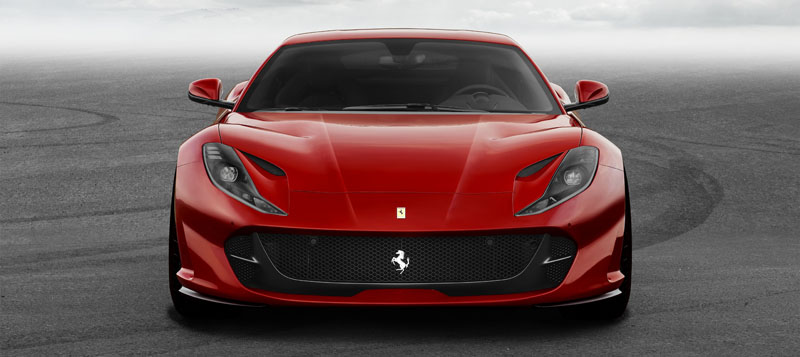
Aerodynamics
The 812 Superfast’s aero design is part of Ferrari’s ongoing commitment to continually improving performance with each new model, both in terms of speed and augmented vehicle dynamics for a more exhilarating driving experience.
The development guidelines aimed to achieve exceptionally high aerodynamic efficiency figures through boosting of the downforce that influences a car’s stability without increasing drag as the latter would negatively impact fuel consumption and maximum speed.
The aerodynamic coefficient values delivered by the 812 Superfast are a significant improvement on those of the F12berlinetta. Mobile aero solutions, whether mechanically activated (active mobile aerodynamics) or activated by the pressure of the air itself (passive mobile aerodynamics), guarantee very low drag values. The choices made in this area were heavily influenced by those debuted on the special F12berlinetta-derived F12tdf, with which the 812 Superfast shares the same downforce values. All its aerodynamic coefficients, however, have been improved.
To the side of the air intakes for engine and brake cooling, is a turning vane on the front bumper which is designed to channel air flows striking the front of car to ensure they hug its flanks, thereby reducing the width of the car’s wake. This in turn appreciably reduces overall drag.
Front downforce generation is entrusted for the most part to a pair of diffusers just ahead of the front wheels, which increase the amount of air drawn in by the underbody. To cancel out the drag associated with them, the diffusers have been equipped with a mobile aero system. When this activates, it completely stalls the diffusers, fairing in the wheel. The mobile surface integrated into the diffuser ramp is activated by the pressure of the air which, as it enters from the lower intake on the outside of the bumper, is channelled towards the mobile surface. When the car reaches a speed where the pressure in the duct is stronger than the calibrated pre-load of an elastic spring, the mobile surface opens, thereby reducing the car’s drag and improving front downforce.
The front diffusers’ capacity to generate downforce is boosted by generous air evacuation from the front wheelarch along the side of the car. This vent on the flanks also directs the energised air flow from the diffusers on the front underbody, preventing pressure build-ups inside the wheelarch and thus improving downforce and cutting drag. This effect is maximised by two sculpted air intakes on the front bonnet by the side of the headlights. The flow is channelled by a specific duct to the front section of the inside of the wheelarch, where it reduces pressure, before energising the flow exiting along the flanks.

The spoiler on the car’s tail also generates downforce. The trailing edge of the spoiler is 30 mm higher than on the F12berlinetta as per the F12tdf. However, unlike the latter, it has not been extended rearwards in depth to avoid changing the car’s dimensions. This has increased drag but is compensated for by the unusual gap at the bottom of the rear screen ahead of the spoiler. This discontinuity causes a separation in the air flow from the rear window, creating longitudinal vortices which boost compression on the surface of the bottom of the windscreen, thereby reducing drag associated with the downforce generated by the spoiler. The shape of the rear wheelarch has also been crafted to guarantee efficient downforce generation. In fact, the lift naturally generated by the way the body curves over the wheelarches has been minimised by introducing an aerodynamic by-pass between the bodywork and the inner rear wheelarch. Rather than following the curvature of the flank in that area, which would create lift, the air flowing over the car’s belt line enters the intake behind the rear quarterlight. It is then channelled into a duct that allows it to exit in front of the rear spoiler. The lift effect of the wheelarches is thus minimised, generating downforce without adding any extra drag.
Three pairs of curved dams that act as vortex generators were adopted for the front underbody and are responsible for 30% of the increase in downforce compared to the F12berlinetta. The dams create a ground effect by generating powerful vortices and reducing the wake from the wheels to the absolute minimum, further boosting the flat underbody’s downforce generation capabilities.
Unlike their F12tdf counterparts, the dams have new blowing slots which, by reducing overall pressure on the front side of the dams, boosts their efficiency, with the result that, despite the downforce generated remaining the same, drag introduced in the area is cut by 15%.
Because of the powerful suction created by the rear spoiler, the rear diffuser has been completely redesigned to enhance its extraction power. Firstly, the diffuser’s trailing edge now features a wing in a deep recess created in the bumper. Air flows from both the lower and upper surfaces strike the splitter which extends across the entire width of the diffuser, boosting the downforce generated by the latter by 12%. Since the rear diffuser is one of the main contributors to downforce generation and the resulting drag, it has also been given a system of three active flaps which rotate to a 14° angle in the minimal drag configuration to completely stall the diffuser, thereby significantly reducing overall drag.
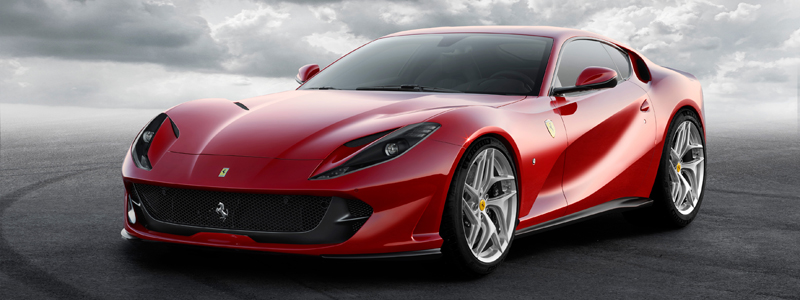
Design - Exterior
Designed by Ferrari Design, the new 812 Superfast redefines the formal language of front-engined V12 Ferraris’ proportions without altering either its exterior dimensions or interior space and comfort.
Seen in silhouette, the 812 Superfast has a fastback sleekness: a two-box design with a high tail reminiscent of the glorious 365 GTB4 (Daytona) of 1969, visually lowering an aggressive rear spoiler designed to guarantee downforce. The draped design of the flanks visually shortens the tail and is characterised by sharply slanted crease lines and impressively muscular wheelarches that imbue the 812 Superfast with the power and aggression warranted by its imposing V12. Full-LED headlights integrated into the design of the sculpted air intakes on the bonnet also emphasise that front muscle, integrating with, and wrapping around the front wheelarch.
The 812 Superfast’s sumptuously sculptural, three-dimensional flanks are characterised by a striking vent behind the front wheels designed to suck high-pressure air from the wheelarches and then channel it along the doors.
The rear diffuser includes a suspended splitter that increases the diffuser surfaces by turning them into bi-plane wing, allowing the air to be drawn between the lower diffuser and the splitter.
At the rear, four round tail-lights inspired by Ferrari tradition emphasise a design crafted around horizontal lines and give the 812 Superfast a broad, imposing stance, visually lowering both spoiler and the very compact cabin without, however, sacrificing its space or that of the boot.
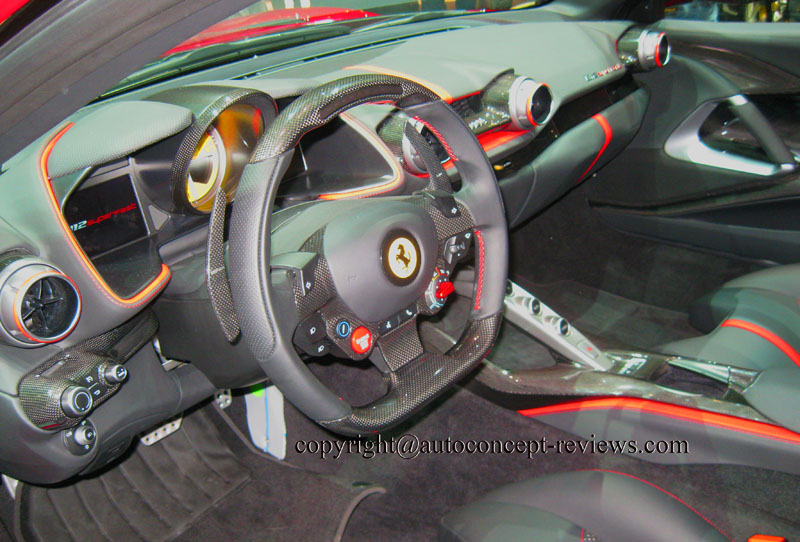
Design - Interior
The cabin has been radically redesigned to imbue it with an even sportier character. Light, compact volumes hug the contours of the interior structures to the extent that the latter are visible in certain areas. These ultra-taut surfaces are deliberately layered and broken up to create voids with the result that the main elements seem to float. The overall effect is both thoroughbred racing eagerness and lean elegance that never feels overstated.
The horizontal dash loops stylishly around the central air vents for a sophisticated, sculptural, yet supremely stylish look that is also a nod to the LaFerrari’s cockpit.
An additional air vent also allowed the designers to lighten the look of the dash still further by creating a “cleft” in the central section that further emphasises the fact that metallic elements stretch out into the upholstered volumes.
The driver zone and central recesses featuring contrasting trim to further underscore their dynamic forms.
The steering wheel and its commands, the satellite pods on either side of it and the interplay of volumes and contrasting materials, combine to create an extreme cockpit in which all of the various elements are angled towards the all-important driver, around whom the volumes curve to highlight his role.
Horizontal character lines create very distinct driver-oriented volumes that also pull off the delicate feat of not excluding the passenger from the action.
The beautifully crafted trimming both at the centre of the dash and around the glove compartment create the just right sense of Ferrari’s signature combination of the artisanal and the high tech.
The seats follow a diapason design language and exploit that expansiveness to create an interplay of solids and voids that lend character to the seat and backrest.
The seats differ from and contrast with the rest of the interior surfaces, thanks to their perforated leather trim which adds a sporty touch to the new styling.
In short, taught forms and cleverly structured volumes combine with superb ergonomics and a light sporty language to yield a top-of-the-range seat.

Optional contents
Ferrari’s vast Personalisation Programme is, of course, also available to ensure each client can make their 812 Superfast unique and even more tailored to their personal tastes and requirements. As is traditional with each new car, the Programme has been further extended to include a wealth of new optionals specifically developed for the 812 Superfast.
Also available is an evolved telemetry system derived from the one aboard the LaFerrari, and a high-end audio system with 12 speakers and a 1,280 Watt amplifier with Quantum Logic for superb sound delivery and quality.
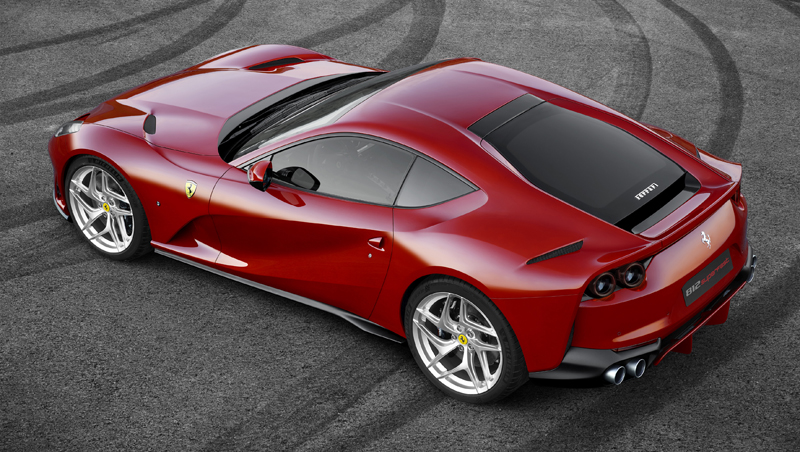
Ferrari 812 Superfast 2017 :
Technical Specifications
Engine |
Type |
V12 -65° |
Overall displacement |
6.496 cc |
Bore and stroke |
94 mm x 78 mm |
Maximum power output** |
588 kW (800 CV) at 8,500 rpm |
Maximum torque |
718 Nm at 7,000 rpm |
Max. revs |
8,900 rpm |
Compression ratio |
13.64:1 |
Weight and dimensions |
Length |
4,657 mm |
Width |
1,971 mm |
Height |
1,276 mm |
Wheelbase |
2,720 mm |
Front track |
1,672 mm |
Rear track |
1,645 mm |
Kerb weight* |
1,630 kg |
Dry weight* |
1,525 kg |
Weight distribution |
47% front - 53% rear |
Boot capacity |
450 l |
Fuel tank capacity |
92 l |
Tyres |
Front |
275/35 ZR20”; 10 ” J x 20” |
Rear |
315/35 ZR20”; 11.5” J x 20” |
|
|
Brakes |
|
Front |
398 mm x 38 mm |
Rear |
360 mm x 32 mm |
|
|
Transmission and gearbox |
4WS/ 7-speed F1 DCT/E-Diff3 |
Electronic controls |
SSC5/CST with F1 TRAC system, ESP 9.1 Premium with High-performanceABS EBD, dual coil SCM-E |
Performance |
Maximum speed |
340 km/h |
0-100 km/h |
2.9 sec |
0-200 km/h |
7.9 sec |
100-0 km/h |
32 m |
| Dry weight/power |
1.9 kg/cv |
| Fuel consumption |
|
| Fuel consumption*** |
14,9 l/100 km |
| Emissions** |
340 g CO2/km |
* Engine power is expressed in kW, in accordance with the International System of Units (SI) and in CV for reasons of homogeneity. With 98 octane-rated petrol
** With optional equipments
*** Combined cycle with HELE System (ECE+EUDC |
Ferrari 812 Superfast 2017 : Wallpapers (click on image to enlarge)
photos & informations P. Damiens, Newspress and Ferrari Media Archives
Related reviews :































